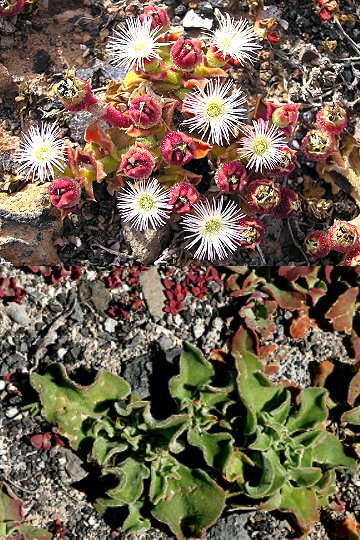
|
|
Iceplant (Mesembryanthemum crystallinum).
Flowers and leaves.
|
Iceplant - Mesembryanthemum crystallinum
Mesembryanthemum (meaning "midday flowering" is a genus of flowering plants native to southern Africa. Mesembryanthemum is a member of the family Aizoaceae.
Many members of the family Aizoaceae have the common name "ice plant" and they are characterized by long-lasting flower heads that remain open during sunlight.
The generic name Mesembryanthemum comes from the Greek words mesembria = midday and anthemon =
flower. Both the generic name is a reference to the flowers which only open when there is strong
sunshine, i.e. usually at noon. The family name Aizoazeae, from the Greek word aizoon = living
eternally, describes the robustness of --our-- plant.
Mesembryanthemum crystallinum is a prostrate succulent plant native to Africa, Sinai and southern Europe, and naturalized in North America, South America,
Australia and coastal areas of Japan. Did not reach Europe and America until the 18th century and the Canary Islands until the 19th century.
The plant is covered with large, glistening bladder cells or water vesicles, reflected in its common names of common ice plant, crystalline iceplant or ice plant. The bladder cells are enlarged epidermal cells. The main function of these bladder cells is to reserve water. It can be annual, biennial or perennial, but its life cycle is usually completed within several months, depending on environmental conditions.
M. crystallinum is found on a wide range of soil types, from well-drained sandy soils (including sand dunes), to loamy and clay soils. It can tolerate nutritionally poor or saline soils. As with many introduced species it also grows in disturbed sites such as roadsides, rubbish dumps and homestead yards.
The plant is a perennial, but is grown in gardens as an annual. The ice plant is a specialist when it comes to getting water. It thrives on sandy-clayey and even salty soils where it can cover areas of up to 0.7 m≤ in the beating sun. Its secret lies in its green or sometimes intensely red leaves. They are thick and succulent and covered with glittering fluid reservoirs which sparkle in the sun like dew drops or ice crystals.
Blades of the leaves widen towards the outer ends and become narrow near the
stalk.
But how the ice plant manages to cope with such great
heat. It does this by holding its breath during the day. Normally plants take up carbon dioxide during the day and convert it to sugar and oxygen with the help of
sunlight. The plant breathes through pores on the undersides of the leaves but it also loses water through
them. So the ice plant closes these so-called stomata during the day and only breathes after
sundown. The carbon dioxide it takes up is bound to a molecule and processed to sugar and oxygen the following morning by means of
photosynthesis.
But that is not all. The ice plant has the initially perplexing oddity that it accumulates
salt. Any normal plant dies if it is exposed to too much salt. We are familiar with this after cold winters when we find that the salt put on icy roads has damaged the
vegetation. But in coastal areas the ice plant even takes up salt from the air if the soil is not
salty.
What does it do with it? The salt stimulates the production of fruit acids in the
plant. And these, together with sugar alcohols, abundant magnesium and the amino acid
proline, provide a natural moisture retaining factor. So these constituents of
--our-- plant actually attract and bind the little moisture present in its
environment. This is demonstrated particularly impressively by cut branches which do not dry out until after many
weeks. The red colour of the leaves completes the heat protection. The colour comes from the
so-called betacyanins, pigments which absorb light and thus provide natural protection against the
sun.
From May to July the ice plant is covered with numerous white to reddish flowers with radially arranged petals. This opulence stands in contrast to the root which is only a few centimetres long, giving the impression that it is only there to hold the plant in the soil rather than to supply it with water. Each tiny, white flower has a swollen calyx covered with the bladders. Seeds are very small, black, and shiny. In damp weather the capsules burst open, releasing the
seeds which need the heat of their native habitat to ripen. Mesembryanthemum crystallinum is frost-sensitive.
Its leaves are edible, as with some other members of the Aizoaceae family. Leaves and stems - raw or cooked. They can be used as a spinach substitute. The leaves have an acid flavour, they are thick and very succulent with a slightly salty tang. They can also be pickled like cucumbers or used as a garnish.
They are commonly featured in Japanese
dishes and tthey are chef's choice in gourmet dishes. South Africans chew the fermented leaves.
Seeds can also be eaten.
as a famine food when all else fails.
The crushed leaves can be used as a soap substitute and has some medicinal uses.
The plant is demulcent and diuretic. It is used in the treatment of inflammations of the pulmonary and genito-urinary mucous membranes. The leaves are used in the treatment of ascites, dysentery and diseases of the liver and kidney diseases and pneumonia. Used externally it relieves
itching, pain, swelling and redness of the skin.
Mesembryanthemum crystallinumt is cultivated as
vegetable in many countries. It is also cultivated for ornamentation.
Source:
https://en.wikipedia.org/wiki/Mesembryanthemum_crystallinum
http://www.dr.hauschka.com/en_DE/knowledge-base/
medicinal-plant-facts/ice-plant/#1
